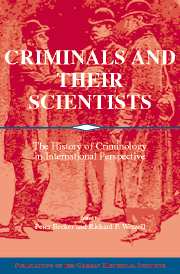Book contents
- Frontmatter
- Introduction
- Part One Nonacademic sites of Nineteenth-Century Criminological Discourse
- Part Two Criminology as Scientific and Political Practice in the Late Nineteenth and Early Twentieth Centuries
- Part Three The Making of the Criminologist
- 13 The International Congresses of Criminal Anthropology: Shaping the French and International Criminological Movement, 1886-1914
- 14 Making Criminologists: Tools, Techniques, and the Production of Scientific Authority
- 15 “One of the Strangest Relics of a Former State”: Tattoos and the Discourses of Criminality in Europe, 1880-1920
- 16 What Criminals Think about Criminology: French Criminals and Criminological Knowledge at the End of the Nineteenth Century
- 17 Talk of the Town: The Murder of Lucie Berlin and the Production of Local Knowledge
- Part Four Criminology in the First Half of the Twentieth Century: The Case of Weimar and Nazi Germany
- Index
15 - “One of the Strangest Relics of a Former State”: Tattoos and the Discourses of Criminality in Europe, 1880-1920
Published online by Cambridge University Press: 05 January 2013
- Frontmatter
- Introduction
- Part One Nonacademic sites of Nineteenth-Century Criminological Discourse
- Part Two Criminology as Scientific and Political Practice in the Late Nineteenth and Early Twentieth Centuries
- Part Three The Making of the Criminologist
- 13 The International Congresses of Criminal Anthropology: Shaping the French and International Criminological Movement, 1886-1914
- 14 Making Criminologists: Tools, Techniques, and the Production of Scientific Authority
- 15 “One of the Strangest Relics of a Former State”: Tattoos and the Discourses of Criminality in Europe, 1880-1920
- 16 What Criminals Think about Criminology: French Criminals and Criminological Knowledge at the End of the Nineteenth Century
- 17 Talk of the Town: The Murder of Lucie Berlin and the Production of Local Knowledge
- Part Four Criminology in the First Half of the Twentieth Century: The Case of Weimar and Nazi Germany
- Index
Summary
There is no law that is not inscribed on bodies. . . . It engraves itself on parchments made from the skin of its subjects. It articulates them in a juridical corpus. It makes its book out of them . . . through them, living beings are “packed into a text,” . . . transformed into signifiers of rules (a sort of “intextuation”), and, on the other hand, the reason or Logos of a society “becomes flesh” (an incarnation).
The tattooed man is thus the one who is excluded, the one who has no meaning, who does not belong to the system of written signifiers. From then on he is the target of literate societies that want to destroy him in order to give themselves the illusion that there is nothing that exists outside their system.
In 1863 Cesare Lombroso (1836-1909), then a military physician stationed with an artillery regiment in Calabria, made an observation that, many years afterward, he claimed as the first dawning of his theory of criminality. “As an army doctor, I beguiled my ample leisure with a series of studies on the Italian soldier. From the very beginning I was struck by a characteristic that distinguished the honest soldier from his vicious comrade: the extent to which the latter was tattooed and the indecency of the designs that covered his body.”
- Type
- Chapter
- Information
- Criminals and their ScientistsThe History of Criminology in International Perspective, pp. 337 - 362Publisher: Cambridge University PressPrint publication year: 2006
- 1
- Cited by



